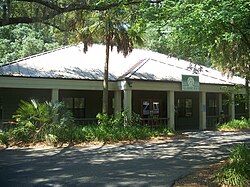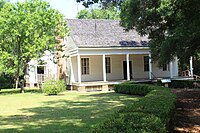Facilities and exhibits
A major strength of the museum lies in the diversity of its exhibits and the multiple utilization capabilities of its facilities.
Wildlife Florida
Another major portion of the museum is devoted to Florida wildlife, with many animals in relatively large, well-vegetated areas, usually similar to native habitats. Of note are black bears, white-tailed deer, and bobcats, as well as several endangered species: red wolves and Florida panthers. There are also several aviaries, a snake exhibit, small mammals, and a "guest" animal habitat, which was introduced in 1988.
Twice a day, there are "Animal Encounters," during which a staff member shows and teaches about an animal. They may show birds of prey, snakes, a rabbit, or a skunk. Many of the animals used for education have been injured, especially birds of prey. Since these animals could not survive in the wild, in accordance with state laws, they must either be used for education or be put down.
Florida & Beyond
This section includes the Fleischmann Natural Science Building with two freshwater aquaria and facilities for bird watching, the Phipps Gallery with changing exhibits of local art, culture and history, and the Discovery Center, a family interactive area with hands-on exhibits about the natural history and culture of North Florida.
Other
The museum also has several nature trails, one of which includes a boardwalk over normally flooded cypress habitat, and a number of special-use facilities for indoor exhibits and workspaces.

The Pythonidae, commonly known as pythons, are a family of nonvenomous snakes found in Africa, Asia, and Australia. Among its members are some of the largest snakes in the world. Ten genera and 39 species are currently recognized. Being naturally non-venomous, pythons must constrict their prey to suffocate it prior to consumption. Pythons will typically strike at and bite their prey of choice to gain hold of it; they then must use physical strength to constrict their prey, by coiling their muscular bodies around the animal, effectively suffocating it before swallowing whole. This is in stark contrast to venomous snakes such as the rattlesnake, for example, which delivers a swift, venomous bite but releases, waiting as the prey succumbs to envenomation before being consumed. Collectively, the pythons are well-documented and -studied as constrictors, much like other non-venomous snakes, including the boas and even kingsnakes of the New World.
The Arizona-Sonora Desert Museum is a 98-acre zoo, aquarium, botanical garden, natural history museum, publisher, and art gallery founded in 1952. Located just west of Tucson, Arizona, it features two miles (3.2 km) of walking paths traversing 21 acres of desert landscape. It is one of the most visited attractions in Southern Arizona.
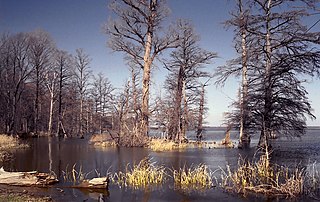
Reelfoot Lake State Park is a state park in the northwest corner of Tennessee in the United States. It encompasses Reelfoot Lake and is situated in Lake and Obion counties. The park itself makes up 280 acres (1.1 km2), divided into ten sections around the lake. A major hunting and fishing preserve, it is part of a much larger wildlife refuge which comprises 25,000 acres (100 km2), 15,000 acres (61 km2) of which are water, and harbors almost every kind of shorebird, as well as the golden and American bald eagles. Other animals are also diverse and abundant. The many species of flowering and non-flowering plants attract botany enthusiasts from all over the country. Baldcypress dominates the margins of the lake, but many other trees and shrubs are also present.

The Florida Museum of Natural History (FLMNH) is Florida's official state-sponsored and chartered natural-history museum. Its main facilities are located at 3215 Hull Road on the campus of the University of Florida in Gainesville.

The Memphis Zoo is a zoo in Midtown, Memphis, Tennessee, United States. It is home to more than 3,500 animals representing over 500 different species. Created in April 1906, the zoo has been a major tenant of Overton Park for more than 100 years. The land currently designated to the Memphis Zoo was defined by the Overton Park master plan in 1888, it is owned by the City of Memphis. The zoo is set on 76 acres (31 ha), of which approximately 55 acres (22 ha) are developed.

The Morley Nelson Snake River Birds of Prey National Conservation Area has one of the densest populations of nesting raptors. The National Conservation Area (NCA) is located 35 miles (56 km) south of Boise, Idaho along 81 miles (130 km) of the Snake River, and is managed by the Bureau of Land Management. The NCA covers 484,873 acres (1,962.21 km2). In descending order of land area it is located in Ada, Elmore, Owyhee, and Canyon counties.

The Great Lakes Aquarium opened in 2000 and is located on the Duluth waterfront. A 501(c)(3) private nonprofit, Great Lakes Aquarium features animals and habitats found within the Great Lakes basin and other worldwide ecosystems such as the Amazon River or Pacific reefs. The aquarium houses 205 different species of fish, birds, reptiles, amphibians, and mammals. It is one of few aquariums in the United States that focuses predominantly on freshwater exhibits.
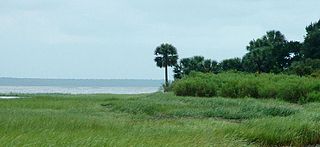
St. Marks National Wildlife Refuge, in Wakulla County, Florida, is one of the oldest wildlife refuges in the United States. Established in 1931 as a wintering ground for migratory birds, it encompasses more than 83,000 acres spread between Wakulla, Jefferson, and Taylor Counties in the state of Florida.

Opheodrys aestivus, commonly known as the rough green snake, is a nonvenomous North American colubrid. It is sometimes called grass snake or green grass snake, but these names are more commonly applied to the smooth green snake. The European colubrid called grass snake is unrelated. The rough green snake is docile, often allowing close approach by humans, and seldom bites. Even when bites occur, they have no venom and are harmless.

The High Desert Museum is located near Bend, Oregon, United States. Opened in 1982, it brings regional wildlife, culture, art and natural resources together to promote an understanding of natural and cultural heritage of North America's high desert country. The museum includes indoor and outdoor exhibits of wildlife in natural-like habitats along with traveling exhibits and living history demonstrations. The museum is accredited by the American Alliance of Museums. It is also a Smithsonian Affiliate institution.

Bellevue Plantation was the U.S. home of Catherine Willis Gray Murat, located in Tallahassee, Florida. It was purchased in 1854 after Catherine's second husband Prince Achille Murat died in 1847. Murat was the great-grandniece of George Washington. She was a daughter of Colonel Byrd C. Willis and his wife Mary Lewis. Mary Lewis was the granddaughter of Fielding Lewis, George Washington's brother-in-law. Through the Lewis family, she was also a relative of explorer Meriwether Lewis.
The Crocodile Lake National Wildlife Refuge is part of the United States National Wildlife Refuge System, located in north Key Largo, less than 40 miles (64 km) south of Miami off SR 905. The 6,686 acre (27.1 km2) refuge opened during the year of 1980, under the Land and Water Conservation Fund Act of 1965 and the Endangered Species Act of 1973. It was established in order to protect critical breeding and nesting habitat for the threatened American crocodile and other wildlife. This area also includes 650 acres (2.6 km2) of open water in and around the refuge. In addition to being one of only three breeding populations of the American crocodile, the refuge is home to tropical hardwood hammock, mangrove forest, and salt marsh. It is administered as part of the National Key Deer Refuge which is also located in the Florida Keys.
Lake Perris is an artificial lake completed in 1973. It is the southern terminus of the California State Water Project, situated in a mountain-rimmed valley between Moreno Valley and Perris, in what is now the Lake Perris State Recreation Area. The park offers a variety of recreational activities. Because of this and the lake's proximity to major population centers, it is very crowded during the summer months.

The Big Bend of Florida, United States, is an informally-named geographic region of North Florida where the Florida Panhandle transitions to the Florida Peninsula south and east of Tallahassee. The region is known for its vast woodlands and marshlands and its low population density relative to much of the state. The area is home to the largest single spring in the United States, the Alapaha Rise, and the longest surveyed underwater cave in the United States, the 32-mile (51 km) Wakulla-Leon Sinks cave system.

Silver Springs is a group of artesian springs that feed into the Silver River in Marion County, Florida. It is the largest artesian spring in the world and the site of the oldest commercial tourist attraction in Florida, and was designated a National Natural Landmark in 1971. Its main features are the glass-bottom boat tours on the river, which have operated there, in various forms, since 1878. Long privately owned and operated, the springs area was formerly the site of a small amusement park, Silver Springs Nature Theme Park.

The life zones of West Virginia allow for a diversity of habitats for fauna, varying from large lowland farming valleys bordered with forest and meadow to highland ridge flats and heavy forestland, some with rocky ridge-line peaks. The "Mountain State" harbors at least 56 species and subspecies of mammals. The state has more than 300 types of birds and more than 100 species of fish.
CuriOdyssey is a science museum and zoo containing animals and interactive science exhibits. CuriOdyssey is home to nearly 100 rescued animals, most native to California, that cannot survive in the wild. CuriOdyssey's exhibits include a science playground where kids play with scientific phenomena.

The Great Plains Zoo and Delbridge Museum of Natural History is a 45-acre (18 ha) zoo and former museum located in Sioux Falls, South Dakota, United States. Prior to its closure, the Delbridge Museum of Natural History displayed 150 mounted animals, including 38 "vanishing species". The Great Plains Zoo is owned and operated through a partnership between the City of Sioux Falls and the Zoological Society. The City of Sioux Falls owns the infrastructure, land, and all assets associated with the Zoo and Museum and maintains the grounds. The Zoological Society of Sioux Falls, a non-profit, operates the facility, manages the animal collection, and maintains the grounds within the exhibit. The mid-sized Great Plains Zoo was awarded the "Quarter Century Award" by the Association of Zoos and Aquariums (AZA) in 2016, marking 25 years of continuous accreditation.
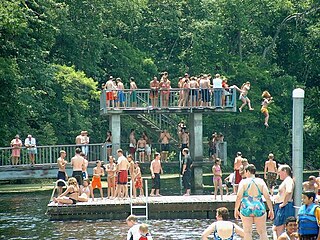
Edward Ball Wakulla Springs State Park is a Florida State Park in Wakulla County, Florida, United States. This 6,000 acre (24 km2) wildlife sanctuary, located south of Tallahassee, is listed on the National Register of Historic Places, and designated a National Natural Landmark.
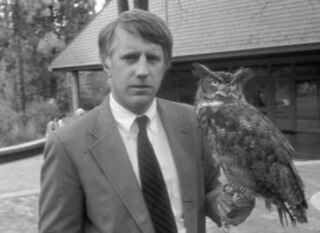
Donald M. Kerr was an American wildlife biologist and conservationist. He founded the High Desert Museum in Bend, Oregon. Kerr led the museum for sixteen years, helping it develop and expand to become one of Central Oregon's most popular tourist attractions. The museum’s Birds of Prey Center and a high desert conservation award are named in his honor.
